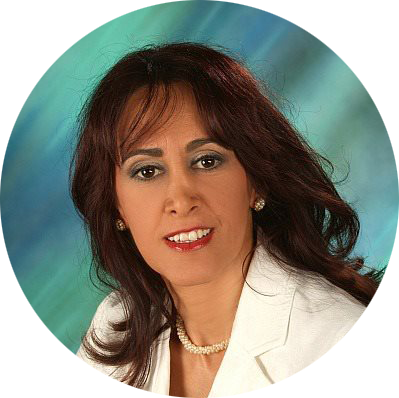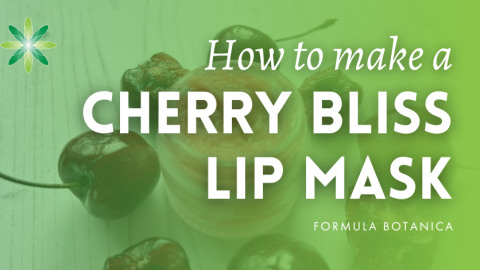Every other month Formula Botanica runs a formulation challenge for its student and graduate community – this month we launch our challenge to make an organic lip balm in a jar. Our students submit their photos and formulations for products that they’ve made, using our guidance. We’ve provided our sample formulation of an Amazonian Lip Balm in this blog post.
In the past we’ve covered formulation challenges such as:
- How to make a natural shower jelly
- How to make a butter scrub
- How to make a body melt
- How to make an aqueous gel using a natural solubiliser
- How to make a body butter
- How to make a natural gel scrub
- How to make a night-time facial oil for mature skin
This month we’re taking it right back to basics and we’re going to learn how to make an organic lip balm in a jar. Although this challenge may seem simple, it is often the most simple formulations that are the most difficult to perfect.
Why do we use Lip Balm?
Given that your lip skin is only 3-5 layers deep, there are no sweat glands. This means that your lip skin doesn’t sweat and it doesn’t produce sebum, your skin’s natural oil. Without sweat and sebum your lips dry out quicker than other parts of your skin. Dry skin is damaged quicker, which is why chapped lips are such as a common occurrence.
A lip balm effectively provides that protective layer that you would normally get from your skin’s natural oils. In covering your lips with an occlusive layer, it does two things – firstly, it locks moisture in and secondly, it makes it harder for the heat and cold to dry out your lips.
When making your own lip balms, keep in mind that the blend needs to be fairly thick so that it sticks to the lips and doesn’t just drip off or absorb too fast. A good balm should have staying power!
Finding the right consistency
We frequently see people come to us to talk about their grainy balms, their problems with using different butters and oils and their struggles in finding the optimal concentration of wax in a formulation. Thankfully we teach our students how to manage all of this in our Diploma in Organic Skincare Formulation and Advanced Diploma in Organic Cosmetic Science.
Our aim for this month is to create a lip balm with a consistency that’s suitable for a jar. This consistency will vary depending on where you are in the world – some hot climates will require a slightly harder balm, whereas those of us in cold climates will need to minimise the amount of harder ingredients. The overall objective is to create a balm that is solid yet creamy in the jar, but can be easily applied with fingers and leaves a pleasant (non-waxy / non-sticky) feel on the lips.
Essential Oils in Organic Lip Balm
All natural or organic lip balms are a blend of waxes and emollients (skin-softening plant oils and butters) and sometimes essential oils for fragrance and flavour. You can also make plain lip balms which are a blend of waxes and butters with no overt flavour or scent to them at all.
Remember that because your lip balm is applied on the lips which have very thin skin, you should consider the safety of your essential oils and only use a small amount of essential oil (generally under 0.5%).
Our Sample Formulation: Amazonian Lip Balm
We created a beautiful orange Amazonian lip balm, rich in carotenoids. Rather than replicate the same ingredients you see everywhere in lip balms, we decided to use some beautiful Amazonian ingredients which not only impart a gorgeous colour to the lip balm but also offer some great functional properties.
Phase A
- Organic myrica fruit wax 25.0%
- Mango butter 25.0%
Phase B
- Vanilla infusion in organic jojoba oil 10.0%
- Buriti oil 39.3% (rich in carotenoids, causes the orange colour)
- Alpha-tocopherol 0.5%
Phase C
- Organic mandarin essential oil 0.2%
Method of Manufacture
1. Melt the myrica wax and mango butter in a water bath at approximately 60-65 oC.
2. Blend phase B and heat it in another bath at approximately 40 oC.
3. When the wax-butter phase has melted, stop heating this phase, remove it from the water bath and add the warm oil phase. I’ve warmed the oil phase to avoid a cold shock. If the oil phase is at room temperature, the wax phase immediately solidifies by adding the oil phase to it.
4. Stir the total mixture and start cooling. You can either do it in a cold water bath or in a fridge (don’t forget to stir in short intervals).
5. When the mixture comes to a trace (you start to see a solid trace in the overall blend), add the essential oil and pour the balm in suitable jars. Do not completely close the jars. Keep the jars in the fridge overnight.
6. Remove the jars from the fridge, close the cap and label them.
7. Judge the consistency of your lip balm after about 24 hours. If the balm feels too hard and waxy, you may need to adjust the formulation by reducing the wax/butter content. If the balm appears too soft and runny you should increase the wax or butter content. Remember that the consistency will vary depending on your climate and environment so don’t be scared to experiment with different ratios.
Now it’s your turn! Either try making our Amazonian lip balm, or design your own formulation. And if you are curious as to how Formula Botanica teaches organic lip balm formulation in our courses, register now for our sample class.
If you are a Formula Botanica student or graduate, the Formulation Challenge for Jan/Feb 2017 will soon be emailed to you and posted in our online classroom. If you’re not a Formula Botanica Community member, leave us a comment below and tell us your experiences in formulating natural lip balms with the right consistency.
FAQs
How do you make the best homemade lip balm?
Natural, organic lip balm would be the best to make at home as many mainstream cosmetic lip balms that are retailed contain petrochemical- or animal product-derived ingredients such as petrolatum or lanolin, from sheep’s wool. For homemade lip balm, you need a combination of waxes like candelilla and myrica to provide hardness along with emollients in both solid and liquid carrier oil form. Common butters include shea and mango, and favourite oils for lip balms are jojoba and sunflower. The tricky part is creating a formula that holds shape as a balm but is also soft enough to apply easily to the lips and has sticking power. You may need to experiment with percentages of waxes to oils and butters and to suit your climate.
How do you make coloured lip balm at home?
To colour a homemade natural lip balm, choose oils and butters with natural hues rather than use synthetic, mainstream colorants or pigments. There are host of gorgeous skin-beneficial oils and butters to choose from. Look for Amazon and African origin butters and oils with deep orange or yellow hues and oils rich in carotenoids. Apart from working with the natural colours from the core ingredients, experiment also with natural pigments in powdered and liquid extracts such as calendula flower macerate in sunflower oil which is a golden yellow or watermelon glycerite with its pink tones.
What is the healthiest lip balm?
Commercial, mainstream cosmetic lip balms are often formulated with petrolatum, a white, soft emollient and a derivative byproduct of petroleum. If you wish to avoid mineral oils and synthetic colorants in your lip balms, opt for those formulated entirely from plant-derived ingredients such as botanical oils, waxes and butters like jojoba and calendula oils, beeswax or vegan waxes and shea, mango and avocado butters.
What is the best natural lip balm?
The best natural lip balm is one that retains shape and structure, is not grainy, has a pleasant hue for lips and is soft enough to apply and won’t drag on the delicate skin of the lips. Making natural lip balm is a fun pastime and also useful, but getting the formulation right to ensure the balm performs well is not as easy as it looks. You may need to experiment with different percentages of waxes to oils and butters to create the perfect balm. Also, try playing around with natural colorants and pigments that are safe for use on the lips to give your balm colour.
Why is it important to use lip balm?
The lips are extremities and have very delicate skin comprising just three layers. They are exposed to harsh elements from biting cold to drying sun and also suffer when we are indoors in overheated homes. The skin on our lips does not have pores so does not sweat nor produce sebum, which is our bodies’ natural skin lubricant. Lips therefore need extra protection from cosmetics like natural lip balms to prevent them from drying out, chapping and even developing in the worst cases small lesions. A natural lip balm acts to keep moisture in and to protect lips from drying out in harsh environments.
Where can I learn to formulate natural skincare and haircare?
Join us at Formula Botanica, where tens of thousands of students and followers take our free and paid online courses to learn how to formulate organic skincare and haircare for themselves or to sell and also how to set up a beauty brand and business.
Leave us a comment

Dr. Elham Eghbali was Formula Botanica’s Cosmetic Chemist between 2014 and 2018. She has over 20 years’ industry experience and is based in Bavaria, Germany. To read more about Formula Botanica’s team, visit our staff page.


























